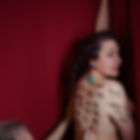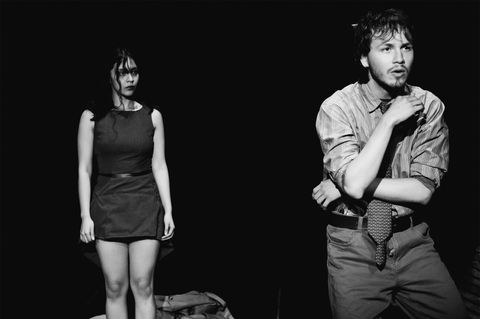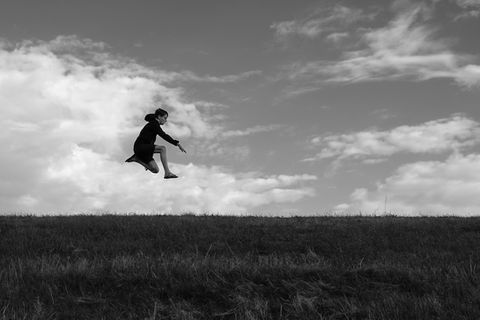
QUARANTINE IN QUEENS
August 30, 2021
INTERVIEW
PHOTOGRAPHY Neil Kramer
INTERVIEW Karin Svadlenak Gomez
Neil Kramer tells stories - with his photos, writing, and films. Humorous and compassionate at the same time, he tackles themes taken directly from human life - including his own. When he found himself locked into a small apartment in Queens, New York, with his mother and ex-wife during the still ongoing Covid-19 pandemic he ended up making the best of the situation: he turned it into a quirky and humorous photo project. His posts of portraits showing the family in often strange situations went viral on social media platforms and have been widely featured on television and in newspapers, and won many awards. We are honoured that Neil agreed to an interview for The Pictorial List, in which he talks to our editor Karin Svadlenak Gomez, about his project QUARANTINE IN QUEENS and how he and his family have been dealing with the pandemic.

“During the early days of the pandemic, it became impossible to do street photography, so it seemed natural to start taking photos of our lives inside the apartment. At the time, Queens, NY was the epicenter of the pandemic in America, and it was scary. Taking the photos became a collaborative way of using art as self-therapy, much in the same way that others started baking bread or knitting sweaters. And because I had some experience in comedy writing in California, I tended to gravitate towards the humor of the situation, at least at first.”
IN CONVERSATION WITH NEIL KRAMER
THE PICTORIAL LIST: Neil please tell us about yourself. When and how did you become interested in photography?
NEIL KRAMER: I’ve always loved photography, but I’ve had more of a career as a writer. I lived in Los Angeles for several years, writing and developing scripts for TV and movies. I also attended film school at USC where I studied film production. I began to fully immerse myself in still photography when I moved back to New York and got hooked on street photography.
TPL: How did it happen that you ended up in quarantine with your ex-wife and mother?
NK: It’s a complicated story, but let’s just say that I was living in my apartment while my mother was in Boca Raton, Florida, but she decided to come back after her lease expired. At the same time, my ex-wife had a plumbing disaster in Los Angeles and she had to move, so she asked if she could stay with me for a few weeks. And then the pandemic happened, and we all got stuck together. And we are still together in this rather tiny apartment with only one bathroom, trying to figure out our next step.
TPL: What triggered the idea for this photo project? And what did your ex-wife and mother think when you presented them with this project idea?
NK: During the early days of the pandemic, it became impossible to do street photography, so it seemed natural to start taking photos of our lives inside the apartment. At the time, Queens, NY was the epicenter of the pandemic in America, and it was scary. Taking the photos became a collaborative way of using art as self-therapy, much in the same way that others started baking bread or knitting sweaters. And because I had some experience in comedy writing in California, I tended to gravitate towards the humor of the situation, at least at first.
My ex-wife and mother already knew that I always had wacky creative ideas, so they were comfortable in playing along. But as the project got more followers on Instagram and we got some media attention, such as in the Washington Post and the Today Show, it became a little more difficult in dealing with the attention.
The series was never intended as a project. It just happened, without a plan. I never expected this pandemic to go on for over 500 days! Usually the daily post was based on a real life experience, which we would restage later in the day when we had more perspective and time.
TPL: The images are quite humorous - does this reflect how the three of you took the entire situation? How much truth is there in these pictures?
The humor in the photos was one of the most confusing aspects of the project. The humor is funny, of course, but it was frequently a coping mechanism to express our own anxieties, and even though some of the shots are over-the-top, they were pretty serious. I think the best humor comes from a real place.
This is a question I get asked a lot, and the best way to answer it is to say “it is true to me.” I'm not a journalist, and the shots are staged in a theatrical manner, but they are all based on truth. My mother did walk in on me when I was in the bathtub, but the photo is a dramatization of the moment which is better composed and lit by speedlights.
TPL: How did it feel for you to become part of the picture? As photographers we are usually behind the camera, most of us are a bit "camera-shy". (Of course there are exceptions, some photographers choose to make a lot of self-portraits.)
NK: Over the last seventeen months, I have taken so many self-portraits, including ones where I am naked, and I have no idea where this side of me was before. I rarely took self-portraits before the pandemic. I don’t have much interest in myself visually. Probably the real reason for so many self-portraits is that it is hard to motivate your impatient family for so many months without them getting pissed at you, so I decided to take more self-portraits because I knew I was always available at 3am.
TPL: Now that a degree of normalcy seems to have returned to life in New York City, do you have a different appreciation of life? What are some of the things you missed especially during lockdown?
NK: It’s funny how things so quickly change. If you asked me these questions two weeks ago, I would have a different answer. Now all of a sudden, the Delta variant is here, and some countries are going back into lockdown. NYC has achieved some level of normalcy, and the greatest gift is seeing friends again. But it's summer now, and we can all meet outside. I’m worried about the fall and winter months, even if we are vaccinated.
What we say, what we do, and what we think can all be different, even when confronted with the same situation, and I like to show the contrast between what I show and what I think.

TPL: We read somewhere that you are a member of Photographers Under Confinement: Engaging Corona Around the World. What does this association do, and how many members does it have?
NK: It’s a Facebook group consisting of hundreds of photographers from around the world, all sharing their pandemic photos on social media. The pandemic has almost become an artistic category nowadays, and there are competitions of Covid-19 related photos. For me, the group was more special - a way to see that this pandemic was truly international. That none of us was alone. This world is so small, and interconnected. It didn’t matter if you were in America, Africa, Asia, or wherever, you had a pandemic story.
TPL: In general regarding your photography, where do you find your inspiration to create?
NK: I feel that I am a storyteller. I always loved stories. Even reading stories as a child. And photography is a great way to tell stories. At the same time, I do feel that photography can be limited in what it can express. That’s why I usually include text with the photo, which I think are equally as important. I don’t feel that it is “cheating” but a way to tell a fuller picture of myself.
What we say, what we do, and what we think can all be different, even when confronted with the same situation, and I like to show the contrast between what I show and what I think.
TPL: Do you have any favourite artists or photographers you would like to share with us, and the reason for their significance?
NK: Photographers I love: Diane Arbus, Nan Goldin, and Richard Avedon. Currently, I am inspired by the humor of Martin Parr and the intimacy of Elinor Carucci.
TPL: When you take pictures, do you usually have a concept in mind of what you want to shoot, or do you let the images just "come to you", or is it both? Please describe your process. What camera/s do you use? Do you have a preferred lens/focal length?
NK: For this project, I usually start with something that happened to me personally that day, and the photo and text becomes a visual diary of that day. The image usually comes first, and then the text expands on it.
I use a crop sensor Sony 6400. Nothing fancy. And because so many photos have been in my super-dark apartment, I've gotten much more skilled in using my inexpensive Godox speed lights. I've also started to tether my photos to my laptop because it allows me to be in my own photos. And because the interiors are so small, I've tended to use a Sigma 16mm wide angle lens for almost all of the interior shots, a lens I rarely used before.
TPL: Where do you hope to see yourself in five years? Are there any special projects you are currently working on other than the quarantine project that you would like to let everyone know about?
NK: Oh, boy. It has been such a weird year and a half. It is hard to know what I’m doing next month. I’ve had some offers from publishers to make Quarantine in Queens into a book, but since I’m still working on it, even after 500 days of posts, I’ve been procrastinating. I’ll also be showing some of my work at international festivals during the fall and winter. I’d like to move on to other projects, but this pandemic just won’t end, will it?
TPL: "When I am not out photographing, I (like to)…
NK: Eat in restaurants, explore the city, go to museums, watch movies, go to the theater, travel. Almost everything that has been hard to do the last year and a half. Hopefully, we’ll all get vaccinated and we can move on to normal life again soon."

Simultaneously humorous and compassionate, Neil's lockdown diary has gone viral. The Pictorial List thanks Neil for sharing with us his journey through the pandemic, and life in the moment, allowing himself to engage in his way of creative thinking. Go live in the moment with Neil and follow him on Instagram or visit his website.







































